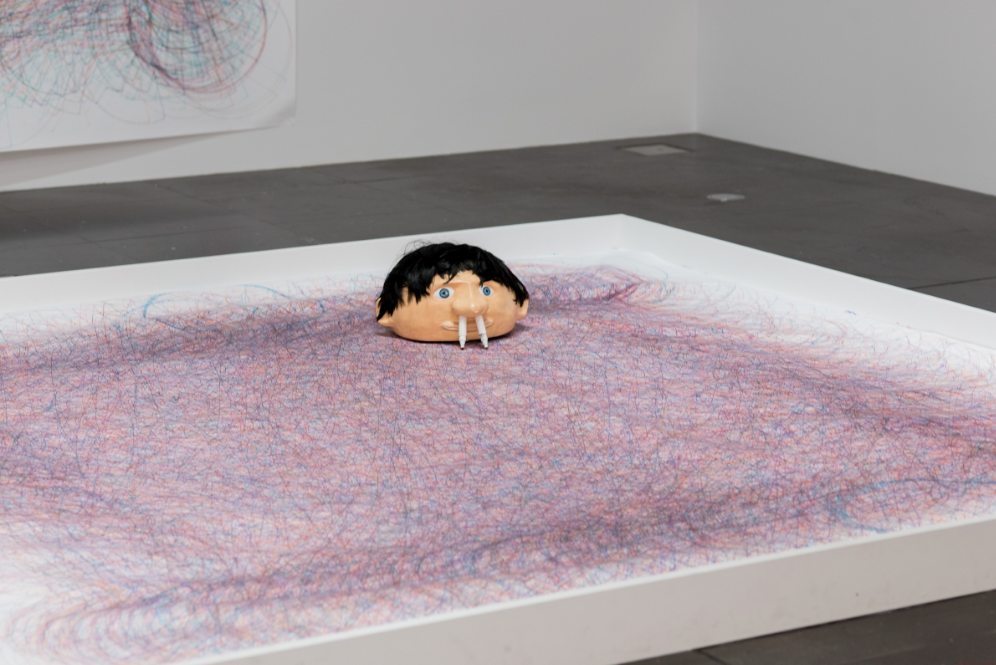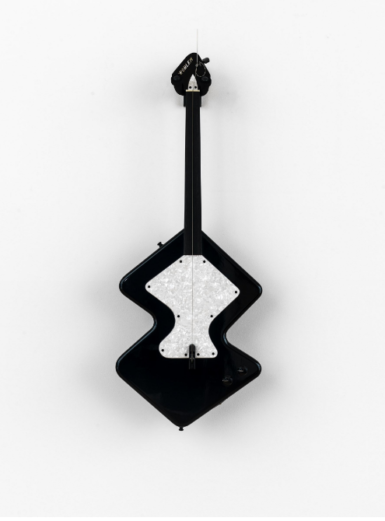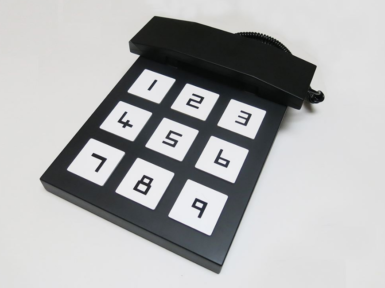[ad_1]

David Shrigley, The Artist .
COURTESY THE ARTIST/STEPHAN FRIEDMAN GALLERY
David Shrigley is known for drawings that balance dark sarcasm with heartfelt modesty. His mix of whimsy and morbidity has also been explored through sculpture, painting, and, over the past few years, music. His new show, “To Be of Use,” is on view at Art Omi in upstate Ghent, New York, through July 21, with new works including five electric guitars, a usable telephone (though with the number zero omitted), a calculator that can only subtract, and a piece called The Artist that is like a Roomba with a face that draws on the floor with markers placed in its nostrils. The exhibition kicked off with a live performance featuring musicians using the sculptural instruments and playing collectively in a piece titled Problem Guitars. Ahead of the show’s opening, ARTnews called Shrigley to ask what it might mean to—as the title proposes—”Be of Use.”
ARTnews: The guitars you’ve made are operational, right?
David Shrigley: Yeah, they’re like a solid-bodied electric guitar, but they have aspects to them that make them challenging to play. They have different scales, and a lot of them have one string. It’s a bit awkward and odd, but they’re still guitars. They’re fully functional objects.
Do you play?
Not very well. I used to be in bands when I was in my 20s. I sort of stopped doing it. I had limited aspirations as a musician. I think I just wanted to be in a band for a while. Mainly as a therapy.
What kind of music did you play?
We were described as indie rock played at the wrong speed.
What kind of music do you listen to? You’ve talked about liking Beck.
He’s one of my favorites in terms of indie pop. He’s someone I listened to in the early ’90s and would still buy his records now. He’s a really diverse and interesting artist. But I like all sorts of things—I tend to oscillate. In the early ’90s, I was listening to Japanese noisy things like Keiji Haino. Then I went through a phase of listening to the kind of music Lee Ranaldo makes when he’s not playing with Sonic Youth.
So pretty cerebral?
Yeah, but then in more recent years I’ve realized I really do like melody. I listen to a lot of pop music. These days, the world is at your fingertips, so you can listen to anything and everything. There’s no real excuse for getting stuck.
The objects in your show are just slightly off. Why doesn’t the telephone you made have a zero key? I wanted to use it to call my mom.
Well, sorry, mum. I suppose, aesthetically, I wanted it to be a square—and it could accommodate nine numbers, as in three rows of three. All of the objects in the exhibition are functional, but their function is denied or made difficult somehow through me making them as artworks. But they are functional, which seems to be the raison d’être for the sculptural artwork I make these days. I don’t make sculptures “of” things anymore—now I make sculptures that “are” things.

David Shrigley, Guitar 1 , 2017.
COURTESY THE ARTIST/ANTON KERN GALLERY
There’s always been sarcasm and darkness in your work but undercurrents of optimism too. Has that been difficult to maintain in such turbulent times?
I don’t really know the answer to that question. I never find it difficult to make artwork, but I think when you’re particularly frustrated, there’s a certain paralysis you feel, as if you just can’t really say anything about [politics] in a way that will be at all profound. But, then again, you can’t really say anything in the vocabulary I use that isn’t going to be profound, because people always project their political context onto what you say.
How do you feel about Theresa May’s resignation as prime minister?
I couldn’t give a rat’s ass about it. I don’t think it makes any difference. She took on an impossible job and was unable to do that job, just as her successor will be unable to. Brexit is undeliverable. I’ve never felt less concerned by the departure of a prime minister. It’s actually ridiculous. To hell with Theresa May—but to hell with the rest of them as well.
You tow an interesting line between being a cartoonist and a fine artist. Have you ever felt offended by the words “doodle” or “cartoon”?
No, I don’t really mind. I think people find the work accessible, so I don’t mind the vocabulary. The only thing I’m not is an “illustrator.” Though, to muddy the waters, I actually have done illustration in the past. I’ve become somewhat aware in recent years that there are several different art worlds. There is the world of graphic art, there is the world of street art, there is the world of the mixture of the two, and then there’s the Basel art world that we both belong to. It’s the Art Basel-type art world that I consider to be my home. That’s my education and that’s what pays my mortgage.

David Shrigley, Telephone .
COURTESY THE ARTIST/ANTON KERN GALLERY
I have a knowledge of the [graphic art world] because there’s a bit of a market for some of my prints and multiples, but also because I’ve known Banksy for a long time. It is interesting that there’s all these artists who do sometimes really interesting things, but you never hear about it because the marketplace is somehow totally different. There are artists like Shepard Fairey that have this massive presence and makes loads of projects, but you just don’t really see them because they’re not written about.
I watched a video of a tattoo event you did several years ago, and it was amazing how quickly you come up with the drawings you do. Is that always how it is for you, or are there projects that require a slower burn?
The thing about those tattoo events that I do periodically is my Dadaist attitude toward [doing] exactly what you’re not supposed to do and see what happens. The graphic for a tattoo is supposed to be considered at length, because it’s there forever. But if you do something completely the opposite, for me, that’s interesting. How I go about making drawings is intuitive. There’s something special about just making a mark and not trying to express something.
The other works that I make have to be considered, especially in collaboration—it’s the realization of an idea, whereas the graphic work is as if the idea comes after. It’s as though I say something and then try to figure out what it means afterwards.
[ad_2]
Source link

